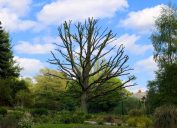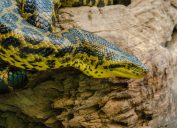Rash-Causing Caterpillars Are "Dropping Out of Trees," Officials Warn
The Tussock moth caterpillar is making its return this spring. Here's how to avoid them.

When it comes to bugs and pests, there are a few we know to keep our distance from. Mosquitoes are up there thanks to those itchy bites, and bees, of course, can have a painful sting. However, you may not have had cause to fear caterpillars—until now. Experts are warning that tussock moth caterpillars have been spotted in the Southern U.S., and they're known to cause skin irritation and rashes.
RELATED: Doctors Keep Finding Spiders in People's Ears—These Are the Tell-Tale Symptoms.
Tussock moth caterpillars were reported in Central and North Florida, prompting warnings from experts: Even though they have a seemingly "fuzzy" appearance, don't go petting them. According to the University of Maine Cooperative Extension, the caterpillars' hairs work as a defense mechanism that lead to an itchy rash.
"These hairs can get lodged in the skin and cause irritation," Dawn Solle, Pharm.D., director of Jacksonville's Poison Information Center, told First Coast News. "You can get redness, bumps to the site, a stinging sensation."
Thankfully, it's not a long-term rash, and the caterpillars themselves aren't venomous or poisonous. As University of Central Florida (UCF) Insect Researcher Jamie Ling told NBC-affiliate WESH, the reaction will actually only last a day or so.
Tussock moth caterpillars are common in these areas of Florida during the spring, with March and April typically being their peak season. In 2024, chillier temperatures have likely contributed to their abundance, Lauren Deipenbrock, PhD, assistant professor of entomology at the University of Florida, told Action News Jax.
"This year it's been a longer cool period. So, it may have synchronized the young leaves on the oak tree, which could then also synchronize the hatching of these caterpillars," she said.
RELATED: 6 Top Signs There Are Snakes in Your Yard.
While you may know enough not to approach these insects on your own, according to Deipenbrock, tussock moth caterpillars can get knocked out of trees and blown by the wind, potentially landing on you. (They can also land in residential foliage and defoliate shrubs.)
"We came outside to the car and the tires of the car underneath these trees were just covered with these caterpillars. They're dropping out of the trees," Brevard County, Florida, resident Kimberleigh Deignan told WESH.
If you find a tussock moth caterpillar has landed on you, remove it without touching it. After that, be sure to remove any caterpillar hairs left behind on your skin using some tape.
"You would take the piece of tape, put it over the area and then pull it off," Solle told First Coast News. "Do that a couple of times to the site to make sure you get all those hairs out."
From there, wash the area thoroughly and apply ice or cortisone to ease any reaction.
If you find the caterpillars in your yard, there's a relatively simple way to get rid of them. Fill a bucket with soapy water and pluck any you see—while wearing gloves or using tweezers—then put them into the bucket.
"They're gonna drown. Just toss them out. It's the easiest option out there," Deipenbrock recommended.
Alternatively, you could simply wait them out. The caterpillars will be cocooning and turning to moths by the end of this month, experts said.





















